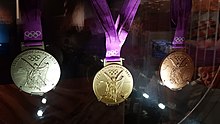Royal Mint
The Royal Mint is the Mint of the United Kingdom . It was founded in 886 and was based in London for almost 1,100 years . It has been located in Llantrisant in south Wales since 1980 . The Royal Mint has been a legally independent company since 2009, wholly owned by HM Treasury and has an exclusive contract with them to manufacture British coins. It also produces coins for numerous other countries. There are also various other coins such as the medals for the Olympic Games in London 2012 . In 2011 the Royal Mint employed 765 people.
history
A mint in London has been recorded since 886, during the reign of Alfred the Great . This London Mint was just one of many in England at the time . In 1279 she moved to the Tower of London , where she stayed for more than five hundred years. In the 16th century it gained a monopoly . From 1547 a Master of the Mint ( mint master ) was responsible for the minting, from 1572 a Warden of the Mint ( Münzwardein ) checked the coins for their fineness and combated counterfeiting. Sir Isaac Newton assumed the post of Warden in 1696, and three years later that of Master. In 1717 he unofficially changed the pound sterling from the silver standard to the gold standard .
During Newton's tenure, the Royal Mint expanded and was housed in several simple wooden buildings around the tower's outer wall. In the 17th century, the production of coins was mechanized and rolling and pressing equipment was installed. The new machines made counterfeiting difficult, but also took up a lot of space, so that there were occasional differences of opinion with the garrison. After the outbreak of the coalition wars , the decision was made to move out of the tower. The new classical building in East Smithfield near the Tower, built by James Johnson and Robert Smirke , was ready for occupation in 1809. The move was completed in 1812.
In the 1880s the building was rebuilt and expanded. The Royal Mint constantly adapted to technical progress. During the Second World War , production had to be interrupted several times as air raids caused great damage. Before the conversion of the pound to the decimal system (1971), the Royal Mint reached its capacity limits, as the entire coin stock had to be re-minted and the foreign customers could not be neglected. The Royal Mint built a new plant in Llantrisant, about 15 kilometers northwest of Cardiff . Queen Elizabeth II opened the first construction phase on December 17, 1968. Over the next seven years, the Royal Mint gradually moved production to Llantrisant. The last coin was minted in London in November 1975. The 1809 London building is now used by Barclays .
literature
- Sarah Barter: The Mint . In: John Charlton (ed.): The Tower of London. Its Buildings and Institutions . Department of the Environment Her Majesty's Stationary Office, London 1978, ISBN 0-11-670347-4 , pp. 117-121 .



